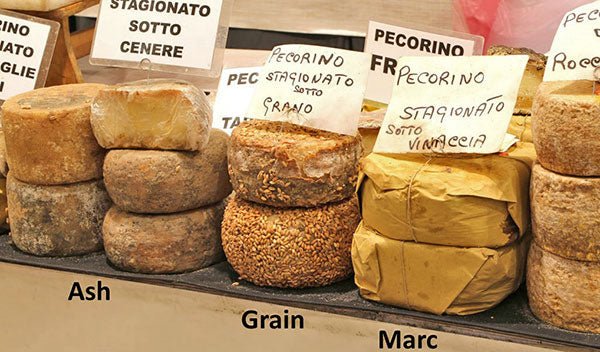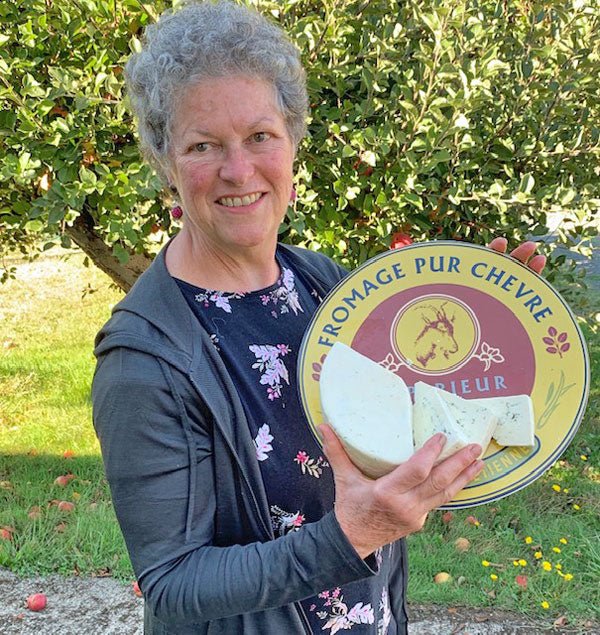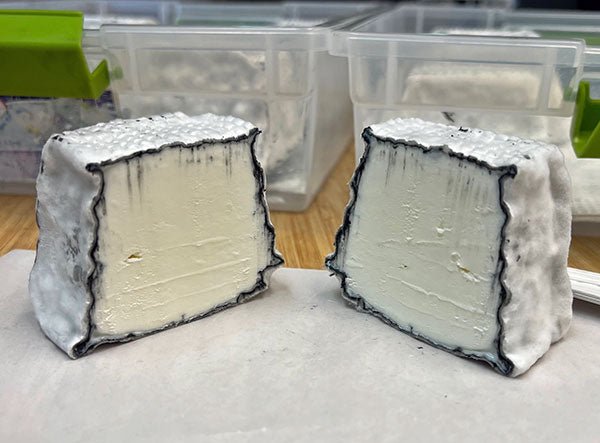One fun aspect of a blog that like this is that we hear from people all over the world (like Yoel Blumberger in Tel Aviv, Israel, interviewed in 2019 – click here). Since then, Yoel has contributed several articles about equipment he has invented for making cheese at home.*
This is his first contribution of a cheese recipe. He learned to make Pecorino Toscano on a trip to Italy.
Pecorino Toscano by Yoel Blumberger
General Introduction
The milk:
Pecorino Toscano is an Italian Tuscan cheese usually made from raw or thermized sheep’s whole fat milk. Thermized milk is raised to 135F (57C) and held at this temperature for 15 seconds.
It can be made with cow’s milk. However, this is a little bit tricky, because the name of the cheese is derived from Pecora, which means sheep in Italian….🙂, so the cheese made from cow’s milk cannot even be called “Pecorino style.”
Generally speaking, the best choice for any cheese is unpasteurized milk, and then thermized and the last choice is pasteurized milk. In this specific case, if you want to be the closest to the original and you are allowed to use thermized milk, this should be your choice. In Israel, for example, milk must be pasteurized, so I pasteurize.
The cheese:
Offered in both young and aged versions, Pecorino cheeses, held in 2020 the fourth place in the list of all cheeses consumed in Italy. Pecorino Toscano itself was the second in the list of the Pecorino cheeses.
In the mid-1800s, it already was a DOP cheese (recognition arrived in 1986) with the Protection Consortium bringing together 20 producers.

Photo from iGourmet.com
The cheese is inoculated with a natural culture, ‘scotta fermento,’ which is produced by acidifying the ‘scotta,’ the whey obtained from the manufacture of ricotta. The ripening period is at least 30 days.
The shape of the finished product is cylindrical with flat faces, and a diameter varying between 15 and 22 cm (〜 6 and 8 inches). The side is slightly convex, with a height between 7 and 11 cm (〜 3 and 4 inches). In any case, the height must never exceed half the diameter. The weight of the forms varies from 1 to 3 kg (2.2 to 6.6 lbs).
The flavor is delicate, with a slight spicy hint. The rind is delicate and thin with yellow color. The cheese is elastic and soft. It’s color is ivory white. There are almost no holes in the cheese.
Varieties:
There are many kinds of Pecorino cheese. They are defined by three main parameters: origin (Sardo, Toscano, and Romano etc.), aging length (fresco, semi stagionato, stagionato) and treatment during aging (crostta rossa – red rind, di fieno – in hay etc.). The picture shows different types of Pecorino Toscano.
This recipe is for the making of four types of Pecorino Toscano cheese:
Pecorino fresco (fresh, short aging)
Pecorino semi stagionato (half aged, aging 2-3 months)
Pecorino stagionato (aged, aging 4-6 months)
Pecorino crostta rossa (with red crust, washed with tomatoes)
The recipe is based on two sources: Pecorino Toscano DOP papers and the way I studied how to produce it in the dairy “Fattoria Pianporcino” in Pienza.
Ingredients:
4 gallons of milk (not ultra-pasteurized)
1/2 tsp Danisco Su-Casu thermophilic culture
1/2 tsp (2.5 ml) single strength liquid rennet
salt
1 tsp calcium chloride dissolved in 1 cup non-chlorinated water (for pasteurized milk)
Instructions:
Heating & Acidifying Milk
Heat the milk to 99F (37C). Add the culture.
A perfect substitute for the originally used ‘scotta fermento’ culture is the Danisco Su-Casu freeze dried culture.
It is so close to the original that in 2007 it became officially accredited and recognized as fit for the production of Pecorino Sardo by the Consortium for DOP Pecorino Sardo Protection.
In the direction section of this culture (on cheesemaking.com) it says “1/4 tsp for 1-2 gallons” so, make the calculation according the volume of milk you work with. If you have an adequate scale, you can use the net weight of the culture and the overall volume it inoculates (both are shown on the label), to calculate the weight of the culture you have to use.
If pasteurized milk is used, add calcium chloride. After adding the culture, wait for 60 minutes.
Coagulating with Rennet
For raw milk, add about 1.75ml (1/4 tsp) of single strength liquid rennet. For pasteurized, add about 2.5ml (1/2 tsp).
The milk now needs to set quietly while the culture works and the rennet coagulates the curd.
After 30 minutes, start checking the firmness of the curd, and if not firm, check every 5 minutes (clear-cut or any other method you use).
Cutting the Curd, Releasing the Whey and Cooking
When the curd firmness is good, begin cutting. Begin with large 4 cm (1.5 inch) spaced vertical cross and diagonal cuts, creating quasi cubes. Wait 5 minutes for the curd to heal.
Stir slowly for several minutes until the curds are of hazelnut size.
Now is the deviation between the different cheese types:
Pecorino fresco – Go directly to the molding phase.
Pecorino semi stagionato – Start slow heating, stir gently, and constantly until reaching 39C, (103F) and curds reach the size of corn grains.
Pecorino stagionato – Start slow heating and stir gently and constantly until reaching 42C (108F) and curds reach size of rice grains.
Molding & Pressing
Move the curd to the mold. Apply slight pressure with the hand on every layer you add.
For the Pecorino fresco, no additional press is needed. Flip the cheese every 1.5 hour during 6 hours and go to the drying phase.
The Pecorino semi stagionato and stagionato are originally pressed in couples by putting one mold on top of the other and after 1.5 hours, the cheese is flipped inside the mold and the molds switch positions, top goes bottom and bottom goes on top. This is done for a total of 6 hours.
If you make only one cheese, weigh your cheese with the mold and apply the same weight on the cheese in your press. First flip is after 1.5 hour. The cheese is further flipped every 1.5 hours. The total press time is 6 hours.
Drying
Keep the cheese inside the mold for 15 hours in 20C-25C (68F-77F). Flipping is optional so this phase can be done during the night.
Salting
Unmold the cheese. The salting phase is executed at the aging temperature, which is 10C (50F). The Pecorino fresco is dry salted. The amount of salt is 2% of the cheese weight. Salt one side and after 24 hours, the other side.
The Pecorino semi stagionato and stagionato are salted in brine. Prepare your usual 20% salt brine. Put the cheese into the brine and then into the fridge. Leave the cheese in the brine for 12 hours then take it out of the brine, dry and return to the fridge for aging. After tasting your first Pecorino, you can change the brining time for the next cheese to be more accurate and to fit your working conditions and taste.
Aging
Aging temperature is 8C-10C (47F – 50F), humidity 85%. Originally, the cheese was aged on wood boards. Aging times are:
Pecorino fresco – 1 month
Pecorino semi stagionato – 2-3 months
Pecorino stagionato – 4-6 months
Flipping is done twice/week.
Pecorino Crostta Rossa
The Pecorino with the red rind is done with the Pecorino semi stagionato or stagionato. This Pecorino cheese is treated (rubbed) with an emulsion made of olive oil and pure tomato paste. The first treatment is done after about 30 days of curing. It consists of a real massage in which the Pecorino cheese is carefully covered with a thin red layer.
For high quality cheese, make the concentrated tomato starting with fresh peeled tomatoes or use a ready, high quality product, without dyes or additives. Mix with extra virgin olive oil.
The treatment is done twice a week, for 4 weeks. The cheese will obtain a thin, semi-hard rind and a brick red color. It’s paste will have a white color tending to straw yellow with the presence of a slightly darker color on the under-crust, due to the treatment of the rind with the tomato and olive oil.
*Previous articles by Yoel:
How to Make Special Containers for Aging Cheeses
How to Make a Peg Mill by Yoel Blumberger
Yoel Blumberger’s Humidity Control System
Yoel’s DIY Cheese Drying Box
Comments: Note: Some folks have had problems making comments. If you make one and it says it can’t be applied, it probably was. The comments are all personally approved, so there is a lag time after you post it. If it hasn’t shown up after 24 hours, please email jeri@cheesemaking.com.





















































































































































